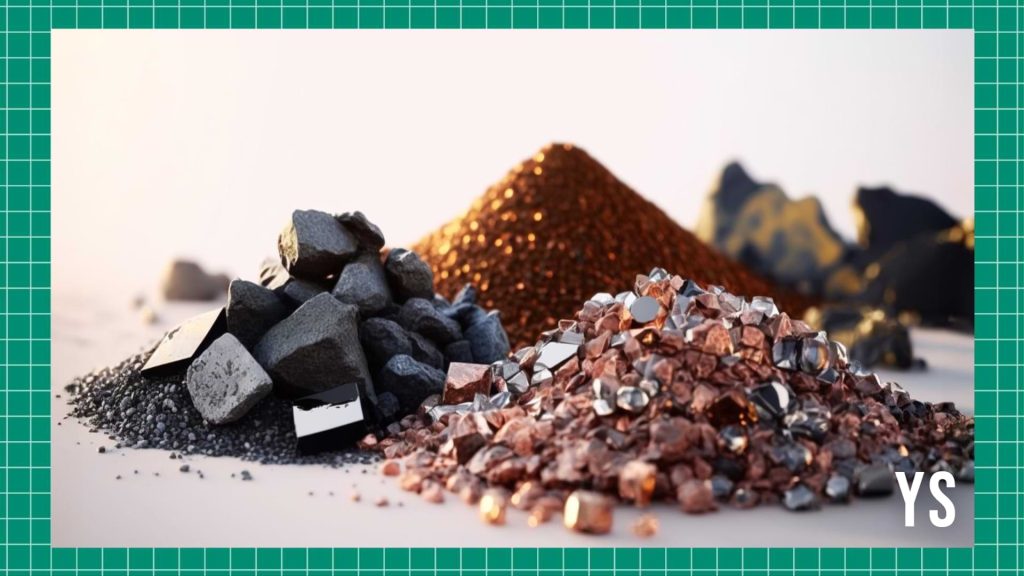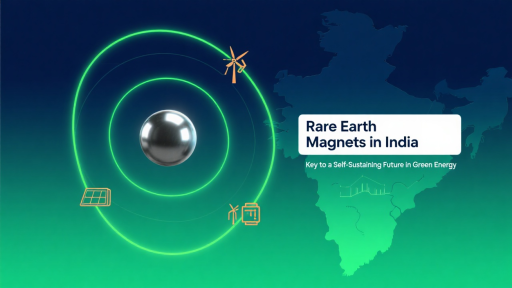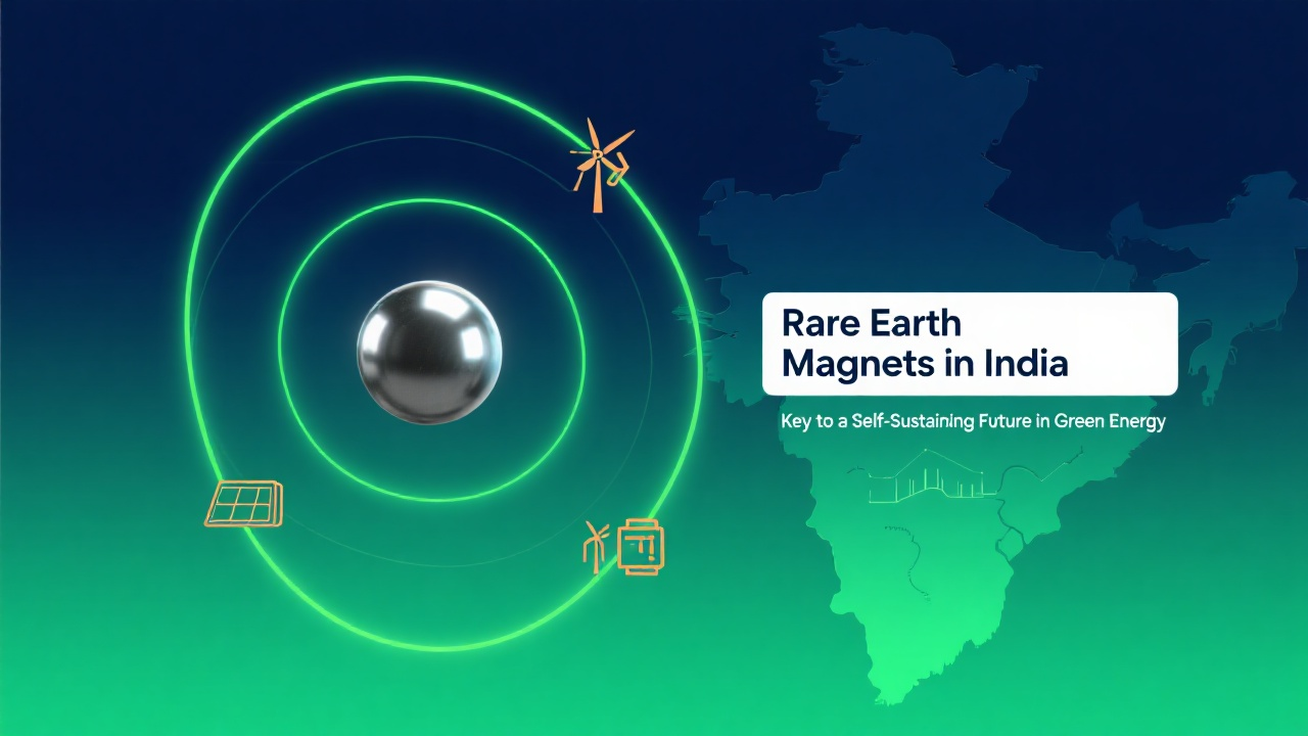INTRODUCTION
The Indian rare earth magnet sector is now set to seize the spotlight in the country’s strategic move to achieve its India rare earth supply chain aspirations. Presently, with about 90 percent of rare earth magnet production and exports controlled by China, India is setting in motion an unprecedented domestic initiative. This article delves into the details of how rare earth magnets in India will reshape the Indian rare earth supply chain to promote autonomy for electric vehicles, electronics, and clean energy.
Why Rare Earth Magnets in India Matter
Rare earth magnets, especially neodymium-iron-boron (NdFeB), are vital for high-performance motors, EV traction systems, wind turbines, consumer electronics, and defense. Without a domestic production of rare earth magnets in India, the rare earth supply chain of India will always remain vulnerable to external shocks.
Prolonged risk in this supply from China can stall the revolution of Indian EV and electronics manufacturing.

Catalyst: China’s Export Curbs
In April 2025, China imposed stringent licensing requirements and export declarations for rare earth elements and magnets, sending shockwaves through the global market. Indian OEMs, including Bajaj, TVS, and Maruti, warned of halting EV output within weeks.
In response, rare earth magnets in India became a national necessity, fast-tracking reforms in the Indiana rare earth supply chain.
Government’s ₹1,345 Crore Initiative
The Ministry of Heavy Industries announced a ₹1,345 crore package targeting core elements of the rare earth magnets in the Indian ecosystem. Incentives cover mining, refining, alloy production, magnet fabrication, and industrial R&D.
The first phase aims to establish two domestic producers capable of converting rare earth oxides into finished magnets, significantly enhancing the Indian rare earth supply chain.
Hyderabad: The New Rare Earth Hub
Confirming plans for a permanent rare earth magnet unit in Hyderabad, Union Minister G. Kishan Reddy stated that a facility set up by a government institute will transfer production-ready technology to private firms within 3 to 4 months.
This rare earth magnet production facility in India will be at the core of the Indian rare earth supply chain, launching manufacturing on Indian soil.
Private Sector Participation and Collaboration
The interest in the domestic production of rare earth magnets in India is evident from the participation of big companies such as Mahindra & Mahindra, Uno Minda, Vedanta, JSW, and Sona Comstar, among others.
With government incentives in place and serious investments in R&D, these players will anchor the Indiana rare earth supply chain to create a competitive manufacturing ecosystem.
Institutes like C-MET, BARC, and DMRL are working in collaboration with the industry for the development and adaptation of magnet technologies. The transfer of technology agreement from C-MET in Ahmedabad represents a strategic leap for rare earth magnets in India and will help strengthen the Indian rare earth supply chain via local innovations.
Related: Rare Earth Magnet Production in India.
Mining, Sourcing, and Public Sector Backbone
India is counted among the top holders of rare earth reserves, but lacks large magnet-grade ore deposits. The majority of mining is done by IREL through beach sand monazite.
The government is promoting exploration in Rajasthan and Gujarat. The government is also sourcing resources from Oman, Vietnam, Sri Lanka, and Bangladesh to strengthen India’s rare earth supply chain and support sustainable magnet production
IREL is expanding its capacity, operating refining and magnet alloy plants in Visakhapatnam and Bhopal. The new Rare Earth Permanent Magnet Plant at Visakhapatnam has commenced its production of samarium-cobalt magnets. Public sector efforts will build India’s rare earth supply chain and domestic magnet production.
Explore and compare thousands of business ideas in one place.
Production-Linked and Fiscal Incentives
To make import costs parallel to those of Chinese magnets, India is rolling out a Production-Linked Incentive (PLI) scheme. This will subsidize the price gap and fund the stockpiling of master magnets. By providing fiscal support, this will make rare earth magnets in India viable while putting in place a resilient India rare earth supply chain.
Overcoming Challenges
While there has been progress, several challenges remain:
- Scarcity of heavy rare earth deposits.
- Complex processing steps from mining to magnetization.
- Regulatory delays in mining permits and environmental clearances.
- Need for infrastructure investment across the supply chain.
Filling these gaps is crucial for India’s rare earth supply chain and scaling rare earth magnet production.
Strategic Importance and Global Diversification
An important aspect of India’s strategy will be building global partnerships and mining abroad. Agreements through KABIL in Argentina, Brazil, and Australia will diversify sources. This will reduce reliance on a single country and strengthen India’s rare earth supply chain for magnet manufacturing.
NdFeB magnets are required for electric vehicles because of their torque and efficiency. India runs the risk of delays in EV production and dependence on domestic rare earth magnets in India. Furthermore, the strategic importance of rare earth magnets in missile defense systems and secure communication strengthens the need for a strong India rare earth supply chain.
Find all of our books here.
Environmental Considerations and Long-Term Roadmap
Extraction has high environmental costs; however, improvements have been made in rehabilitation and emissions control. The India rare earth supply chain initiative must incorporate sustainability practices for rare earth magnets in India, which should be congruent with India’s green tech and clean-energy objectives.
India’s multi-year strategy encompasses:
- Invitation toward exploration and addition to reserves.
- Fostering local industries in producing rare earth magnets in India.
- Constructing infrastructure for the conversion of oxides into finished magnets.
- Collaboration with the private sector and academia.
- Diversity in the global supply chain.
- Incentives and fiscal support.
Leveraged by an integrated national strategy, this will create stability across the Indian supply chain.
What’s Next
- Finalize guidelines on PLI and initiate grant disbursement.
- Operationalize the Hyderabad magnet unit and hybrid public-private models.
- Fast-track exploration and processing permits.
- Identify wider partnerships with global producers.
- Spur R&D to advance specific magnet performance parameters and sustainability.
Every milestone moves India closer to a strong India rare earth supply chain tethered to in-country rare earth magnets in India.
Find the Best Idea for Yourself With our Startup Selector Tool
Conclusion
The global contest for strategic minerals has revved up India’s chase after rare earth magnets in India and a secure India rare earth supply chain. Intelligent policy, huge investment, and cross-sector cooperation are converting India from being an importer to a producer.
This self-reliance would power the expanding EV boom, renewables, electronics growth, and national defense—securing a tech-resilient future.
For more information, check out this Related video.
Frequently Asked Questions (FAQ)
Q1: Why are rare earth magnets important for India?
A: Rare earth magnets, such as neodymium-iron-boron (NdFeB), are crucial for high-performance motors, electric vehicles (EVs), wind turbines, electronics, and defense. Without domestic production of rare earth magnets, India’s supply chain remains highly vulnerable to global disruptions, especially from China’s dominance.
Q2: What triggered India’s push for rare earth magnet self-sufficiency?
A: China’s imposition of strict export controls on rare earth materials in April 2025 highlighted risks and prompted India to accelerate domestic rare earth magnet manufacturing and supply chain reforms.
Q3: What is the government’s plan for developing rare earth magnets in India?
A: The government launched a ₹1,345 crore initiative providing incentives for mining, refining, alloy production, magnet fabrication, and R&D. The first phase seeks to establish two domestic producers capable of converting rare earth oxides into finished magnets.
Q4: Where is India’s new rare earth magnet hub located?
A: A new magnet manufacturing unit is being established in Hyderabad, which will transfer production-ready technology to private firms. This unit is central to India’s strategy for a robust rare earth supply chain.
Q5: Which private companies are participating in India’s rare earth magnet initiative?
A: Major players like Mahindra & Mahindra, Uno Minda, Vedanta, JSW, and Sona Comstar are investing in the sector, leveraging government incentives and focusing on building a competitive local ecosystem.






